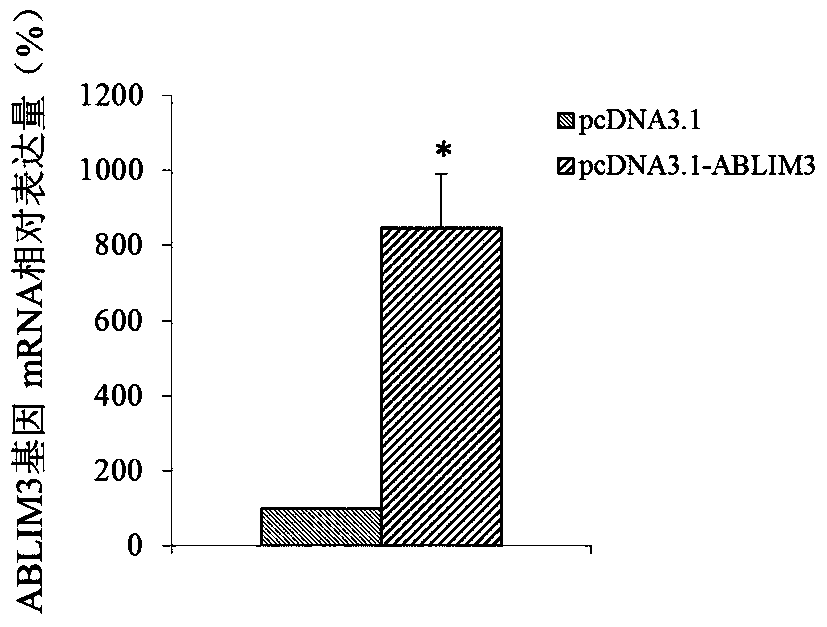The use of ablim3 gene as a marker for the diagnosis and treatment of esophageal cancer
A technology for esophageal cancer and genes, which is applied in the detection/testing of microorganisms, medical preparations containing active ingredients, drug combinations, etc., can solve the problems of unsatisfactory effect and low survival rate of advanced esophageal cancer
- Summary
- Abstract
- Description
- Claims
- Application Information
AI Technical Summary
Problems solved by technology
Method used
Image
Examples
Embodiment 1
[0059] Example 1 Differences in the expression of ABLIM3 gene in normal esophageal tissue and esophageal cancer tissue
[0060] 1. Experimental materials:
[0061] The esophageal cancer tissue is the specimen removed by the hospital's thoracic surgery, and the normal tissue is the specimen taken out under the microscope of the gastroscope room. Cut with a scalpel blade.
[0062] All cases were confirmed pathologically. Including 40 cases of esophageal cancer tissue and 30 cases of normal esophageal tissue. Among them, there were 34 cases of esophageal squamous cell carcinoma and 6 cases of esophageal adenocarcinoma. Normal esophageal tissue was used as the control group. All patients were pathologically confirmed before operation, and no radiotherapy, chemotherapy and other treatments were performed before operation, and no tumors in other parts were found. All tissues were stored in liquid nitrogen within half an hour of the operation, and then transferred to a -80°C ref...
Embodiment 2
[0120] Embodiment 2 ABLIM3 gene expression plasmid construction
[0121] 1. Construction of ABLIM3 gene expression vector
[0122] Amplification primers were designed according to the coding sequence of the ABLIM3 gene (as shown in SEQ ID NO.1). Amplify the coding sequence of the full-length ABLIM3 gene from the cDNA library of adult fetal brain (clontech company, article number: 638831), insert the above cDNA sequence into the eukaryotic cell expression vector pcDNA3.1, and connect the obtained recombinant vector pcDNA3.1 -ABLIM3 was used in subsequent experiments.
[0123] 2. Culture and transfection of esophageal cancer cells
[0124] 2.1 Cell culture
[0125] The esophageal cancer cell line ECA109 was inoculated in DMEM medium containing 10% fetal bovine serum, and placed at 37°C, 5% CO 2 Cultivate in an incubator, and when the cells reach 80% confluence, they are digested and passaged with 0.25% trypsin.
[0126] 2.2 Cell transfection
[0127] Esophageal cancer cell...
Embodiment 3
[0140] Example 3 Effect of ABLIM3 gene on the proliferation of esophageal cancer cells
[0141] MTT assay was used to detect the effect of ABLIM3 gene on the proliferation ability of esophageal cancer cells.
[0142] 1. Steps: trypsinize each group of cells 12 hours after transfection, make a single cell suspension, inoculate 6,000 cells per well in a 96-well culture plate, set 3 time points for each group, and set 6 times for each time point. multiple holes. After the cells adhere to the wall, perform the first test: add 20 μl of 5g / L MTT solution to each well, continue to cultivate for 4 hours, aspirate the medium, add 150 μl of DMSO, and carefully blow and beat to fully dissolve the purple-blue precipitate. The instrument measures the absorbance value (A value) at a wavelength of 490nm. Then every 24h detection 1, continuous measurement 72h, a total of 3 times.
[0143] 2. Statistical methods
[0144] The experiments were all repeated three times, and SPSS13.0 statistic...
PUM
 Login to View More
Login to View More Abstract
Description
Claims
Application Information
 Login to View More
Login to View More - R&D
- Intellectual Property
- Life Sciences
- Materials
- Tech Scout
- Unparalleled Data Quality
- Higher Quality Content
- 60% Fewer Hallucinations
Browse by: Latest US Patents, China's latest patents, Technical Efficacy Thesaurus, Application Domain, Technology Topic, Popular Technical Reports.
© 2025 PatSnap. All rights reserved.Legal|Privacy policy|Modern Slavery Act Transparency Statement|Sitemap|About US| Contact US: help@patsnap.com



